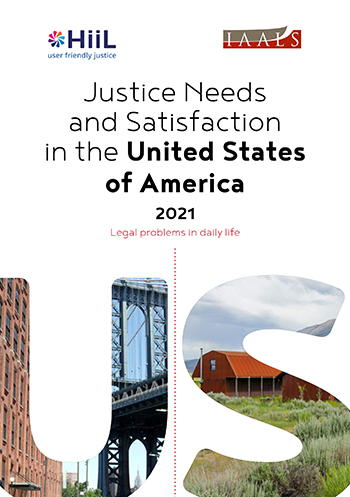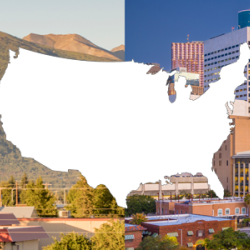The US Justice Needs Study: A Watershed Moment for Achieving Equal Access to Justice
 In the fall of 2019, IAALS and HiiL joined forces and launched a nationwide study to assess the justice needs of individuals in the United States. Today we have released a comprehensive report summarizing the results of this study, with the goal of providing data on the problems that people experience and the ways they seek to resolve them. Understanding people’s broad need for justice—and the extent to which this need is not met—is key to understanding how our society can more effectively help them resolve their problems. Through our research, we now know what people need help with most and what has proven to work best in their lives in realizing justice—and we can begin to chart a new path forward to improve our justice system nationwide in an evidence-based, people-centered way.
In the fall of 2019, IAALS and HiiL joined forces and launched a nationwide study to assess the justice needs of individuals in the United States. Today we have released a comprehensive report summarizing the results of this study, with the goal of providing data on the problems that people experience and the ways they seek to resolve them. Understanding people’s broad need for justice—and the extent to which this need is not met—is key to understanding how our society can more effectively help them resolve their problems. Through our research, we now know what people need help with most and what has proven to work best in their lives in realizing justice—and we can begin to chart a new path forward to improve our justice system nationwide in an evidence-based, people-centered way.
Key Takeaways
We surveyed 10,058 people in the United States and asked them about their justice needs. They identified the problems they experienced over the last four years, what they did to solve these problems, and ultimately whether they felt they reached a fair resolution. What we gained was information and insight into the justice needs of the American people. This bottom-up, evidence-based approach allows us to build out a picture of the overall justice crisis in our country based on the day-to-day experiences of people. This study provides critical information and insights into where justice innovation can have the greatest impact.
Clear evidence of an access to justice crisis in the United States
Access to justice is a problem that is impacting people from all walks of life, with serious social, legal, economic, and political consequences.
The justice crisis is not equally distributed
While access to justice is a broad societal problem, the effects of the justice crisis are not equally distributed. The nature, seriousness, and resolution rates of the problems Americans experience are shaped in meaningful ways by their income, gender, race and ethnicity, age, and living environment. The following groups are most disadvantaged in terms of reaching a fair resolution: lower income, women, multiracial and Black Americans, younger and middle-aged, and those living in urban and rural environments.
The justice crisis negatively impacts lives
This study highlights the wide range of consequences that result from these legal problems and the justice journeys that people experience, such as negative emotions, negative impact on mental health, loss of money, loss of time, and negative impact on financial well-being.
There are many different paths to justice
People in the United States pursue many informal and formal strategies for resolving their legal problems.
These are just a few of the study highlights. The report, which you can find here, highlights in depth the landscape of legal problems and the U.S. justice crisis, the impact of those legal problems, the justice journeys people take to resolve those problems, interventions and treatments that are effective, and where people go for legal information and advice.
How can we use this data?
Fueled with this data, it is critical to ask: how can we use this data to achieve user-friendly justice? Justice that is affordable, accessible, and easy to understand for all.
To change the way we think about access to justice.
First and foremost, we must use this data to change the way we think about access to justice in the United States. When Americans think of justice, they often think of the outcomes of a court case—or they envision the “hallowed halls of justice” in a courthouse. This study provides a different picture entirely. Justice, for many, looks quite different, and there are many different journeys people take to access justice and resolve their problems. They also seek help from a variety of formal and informal sources—not just courts and lawyers. By understanding how people resolve their justice needs, we are no longer boxed into a singular problem type, a singular aspect of our justice system, or a singular experience.
Through this data, we also see that the access to justice crisis is much broader and deeper than traditionally described. While this study confirms there is an important vulnerable population of low-income individuals who are impacted in serious ways, it also reflects that the access to justice crisis is not limited to those with low income. Access to justice is a broad societal problem that affects everyone no matter their age, income, or racial/ethnic group. The justice gap has serious social, legal, economic, and political consequences across our population, and this crisis demands that we change how we think about the full scope of the crisis in order to fully address it.
Although access to justice is a broad societal problem, there are certain groups that are particularly disadvantaged. We have to recognize—and reckon with—the fact that the justice crisis is not equally distributed. Certain sociodemographic groups are particularly disadvantaged in terms of access to justice. This is not new to many, but what this study gives us is critical data and a better understanding of this inequity, which underscores the need for reform and the data to achieve it. While much focus has been called to racial injustice in our criminal system, we must recognize this same inequity in our civil justice system. We must commit to reform so that we can ensure the needs of all are met in an equal, equitable, and fair way.
To more specifically target reform for greater impact.
While the overall outcomes of this study are critical to understanding the full extent of the access to justice crisis in the United States, this data holds even more promise when looked at through specific lenses, such as the experiences of individual socio-demographic groups, legal problems, interventions and treatments, and unique justice journeys. It is by separating the data into its component parts that we can learn even more.
In the end, the data reflects that there is no single justice intervention that increases the likelihood of a problem being completely resolved. The data does not provide a single bullet for fixing our justice system. This is no surprise, and IAALS has advocated for years that there is no one-size-fits-all approach to providing justice. Rather, more tailored approaches can lead to improved outcomes. This is what our data supports.
One place of focus in the data—the problems that are most frequent and which have the greatest impact on peoples’ lives—warrants high attention: employment, personal injury, family, domestic violence, money-related problems, and crime. By looking into the data in these and other areas in a targeted way, we can target reforms to have greater impact.
One of the key goals of this study is to provide the data needed for policymakers and providers of justice services to help prevent legal problems from occurring in the first place, and to help them resolve those that do occur in a fair and effective way. In addition to continuing to analyze the data with an eye toward reform, we will launch a data dashboard this fall to provide others with even greater access to this data and its various segments.
To spur wider engagement and investment in civil justice system improvement.
The justice crisis in the United States will continue for as long as we fail to fully acknowledge the crisis and fully fund justice solutions. This data is a crucial step toward fully understanding the justice challenges we face and providing insights into targeted solutions. That goal is not just for those who are already steeped in justice system reform. It is equally—if not even more important—to provide data to those outside the justice sector. On an annual basis, 55 million Americans experience 260 million legal problems. From the perspective of those experiencing these problems, 120 million of those legal problems are not resolved fairly every year. This data tells us that barriers to justice exist across the spectrum of society, and solutions need to be developed at the societal level—not merely within the justice sector. To do this, we need broad engagement and investment in system improvement.
To urge and inspire innovation.
We also need innovation. Through the pandemic, we have seen innovation happen at a scale and pace that we have not seen before in our justice system, so we know such innovation is possible. We also know that innovation, informed by data, is even more powerful. We know from the data that innovation is already happening, and that people are taking advantage of innovations in justice services—both formal and informal—to meet their justice needs.
“Developing standardized, scalable justice services should be a priority. The service delivery models of law firms, courts, and other formal justice institutions need to evolve and be complemented by innovative models. A substantial investment in R&D is needed for this.”
What better use for this study—and this data—than to fuel innovation and, in doing so, close the justice gap and achieve user-friendly justice for all.
To power our work at IAALS.
We will continue to dive deeply into this data, taking these lessons above to heart and turning them inward. This is a call to action to the entire justice system, but it also serves as a renewed call to action for IAALS and our work. There is more to come this fall, as we share additional results related to the survey questions on justice needs in the pandemic, insights from the data on race and ethnicity, lessons learned from how people are using the internet, and deeper dives into certain problem types. We will also continue to focus outward, sharing this data and engaging others in our work. This is a watershed moment for achieving equal access to justice in America, and we hope you will join us in this mission.



